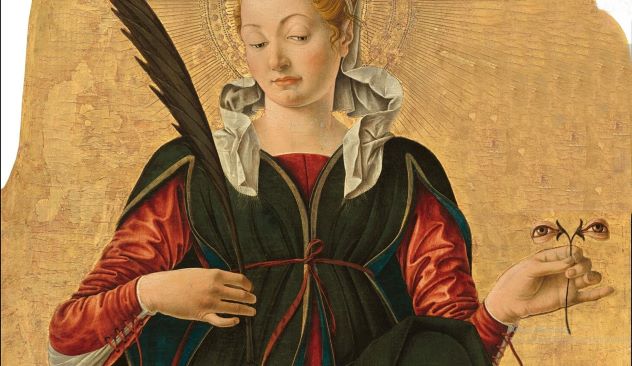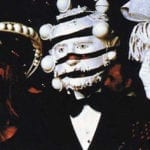 Humans
Humans  Humans
Humans  Movies and TV
Movies and TV 10 Holiday Movies Released at Odd Times of the Year
 Politics
Politics 10 Countries Where Religion and Politics Are Inseparable
 Weird Stuff
Weird Stuff 10 Freaky Times When Famous Body Parts Were Stolen
 Miscellaneous
Miscellaneous 10 Interesting Things Manufacturers Stopped Making and Why
 Gaming
Gaming 10 Funny Tutorials in Games
 History
History 10 Fascinating Little-Known Events in Mexican History
 Facts
Facts 10 Things You May Not Know about the Statue of Liberty
 Movies and TV
Movies and TV 10 Movie Adaptions That Brought Popular Songs to Life
 Health
Health 10 Miraculous Advances Toward Curing Incurable Diseases
 Humans
Humans 10 One-of-a-kind People the World Said Goodbye to in July 2024
 Movies and TV
Movies and TV 10 Holiday Movies Released at Odd Times of the Year
 Politics
Politics 10 Countries Where Religion and Politics Are Inseparable
Who's Behind Listverse?

Jamie Frater
Head Editor
Jamie founded Listverse due to an insatiable desire to share fascinating, obscure, and bizarre facts. He has been a guest speaker on numerous national radio and television stations and is a five time published author.
More About Us Weird Stuff
Weird Stuff 10 Freaky Times When Famous Body Parts Were Stolen
 Miscellaneous
Miscellaneous 10 Interesting Things Manufacturers Stopped Making and Why
 Gaming
Gaming 10 Funny Tutorials in Games
 History
History 10 Fascinating Little-Known Events in Mexican History
 Facts
Facts 10 Things You May Not Know about the Statue of Liberty
 Movies and TV
Movies and TV 10 Movie Adaptions That Brought Popular Songs to Life
 Health
Health 10 Miraculous Advances Toward Curing Incurable Diseases
10 Ways Cultures Around the World Are Obsessed with Eyes
There is one part of the human body that has been the greatest source of numerous myths, legends, and superstitions—the eye. The symbolism of the human eye has been found in cultures around the world for thousands of years, and many of these symbols still exist today.
The eyes have long been considered the windows to our soul, the omniscient presence of God, of prophecy, and as symbols of inner spirituality and the cosmos. Here is a list of ten ways cultures around the world are obsessed with eyes.
Related: 10 Body Parts That Are Secretly Awesome
10 The Evil Eye
Most cultures around the world have some version of the evil eye. Whether it’s the “mal de ojo” in Mexico, the “mati” in Greece, or the “ohlo gordo” in Brazil, all of them share one thing in common—that a person could be cursed or harmed with an unwanted gaze or stare given out of jealousy or envy.
Believed to have originated in ancient Greece or Rome, the eyes were considered to have strong powers which could be used to curse or hurt someone with merely a glance. Over the centuries, the superstitious belief of the power of the evil eye took hold across the world, taking unique elements from the various cultures that embraced it.
Various methods and cultural artifacts were used to ward off the evil eye. Brides used veils to escape the glare of jealous people. Newborn boys, prized in ancient cultures, were given protective amulets with blue beads. And, in India, babies’ eyes were lined with kajal, a form of powdered charcoal.
Wherever you find yourself in the world, ancient symbols of the evil eye are sure to be found.[1]
9 The Eye of Horus
Look no further than the Eye of Horus, which originated in ancient Egypt, as an eye symbol still seen around the world today. According to Egyptian myth, Horus lost his eye in a battle to avenge his father’s death. After his eye was magically restored by an Egyptian goddess, the symbol of his eye—the Eye of Horus—became a talisman that represented protection, health, and restoration. It was one of the most frequently used symbols in ancient Egypt and has been discovered in tombs dating back to the Fourth Dynasty (c. 2613–2494 BC).
The Eye of Horus is made up of six parts, each one representing a fraction of a geometric formula. Amazingly, when superimposed over an image of the human brain, each section corresponds to one of six major sensory centers. These sections are believed to represent the six senses—smell, sight, thought, hearing, taste, and touch. Many sources believe the RX symbol we see on all our doctors’ prescriptions today evolved from the Eye of Horus due to its connection with healing powers.
Even today, the Eye of Horus can be seen in many homes, used as a symbol for protection from danger or threats. [2]
8 Ocular Opals
Opals are the only gemstones that naturally refract light, in a process eerily similar to the way the human eye sees color. In the human eye, light travels through a prism, and wavelengths separate into the different colors we see. In opals, the white light splits into the colors of the spectrum and bounces back to give each gemstone its distinct color pattern.
For some, the stones were prized for their magical qualities. They were thought to protect them from eye diseases and could possibly even make them invisible. The opposing view, however, was that they were evil incarnate. Witches were said to use black opals to increase their powers or to possess people they wanted to harm, and some linked the opal to the eyes of detested creatures like toads and snakes.
In the Harry Potter book series, JK Rowling references opals three times. Using the folkloric belief that opals provide “eyes” to see the future, she uses them as a powerful symbol of vision and to predict what might befall the witches and wizards of her fictional world.[3]
7 Fill in the…Daruma Dolls
Look at a daruma doll, a traditional Japanese doll, and the first things you notice are its eyes.
When first purchased, the odd-looking dolls, featuring a bearded man’s face, contain oversized, blank, white circles for eyes. The big eyes are only left blank temporarily, however—an eyeball will be painted in one of the eyes upon receipt of the doll as a gift. The second eye will only be filled in when a determined life goal or wish has been attained.
The dolls are modeled after a 5th-century monk named Bodhidharma, who, legend says, faced a cave wall in deep meditation for five years. He was so committed to his search for enlightenment that eventually, his body atrophied, but his spirit remained steadfast. The eyes on the doll represent his determination and the eye-on-the-prize mental strength needed to accomplish his goal.
Unsurprisingly, the expression “Both eyes open” is commonly used in Japan to wish someone the best of luck and success.[4]
6 Third Eye of Shiva
Legend has it that the Hindu god Shiva opened his third eye after being shot at with an arrow by Kama, god of lust. He burned Kama to ashes out of anger and frustration at being tempted by him. In the Buddhist and Hindu religions, “awakening one’s third eye” is a metaphor for achieving inner clarity, as Shiva did in order to crush his temptation.
Commonly seen on women worldwide, the bindi—a colored dot or sticker placed on the forehead—is linked to the importance they put in the symbolism of the third eye. It is said to be placed on the spot of the sixth chakra, or energy points, located slightly above and between the eyes and is linked to wisdom.
Scientists describe the pineal gland as a dormant “third-eye” controlling the hypothalamus, which plays an important role in releasing hormones and regulating behavior. Famed scientist René Descartes also referred to the pineal gland as a third eye, the place where all of our thoughts are formed and the principal location for the soul.[5]
5 Unmatching Eyes
We all know about Alexander the Great, the legendary king of Macedonia who changed the course of history, but did you know he had two different colored eyes—one blue and the other one brown? He is said to have had heterochromia—a condition that occurs when a melanin imbalance occurs in the irises.
There was a time when people with two different colored eyes were feared. In some Eastern European cultures, a child born with heterochromia was thought to have had one eye replaced the eye of a witch. People with the condition were considered evil and were connected to supernatural events. Today, heterochromia is regarded as a unique, intriguing trait. Some recognizable people with the condition are Kate Bosworth, Dan Akroyd, Jane Seymour, and New York Mets pitcher Max Scherzer.
Some animals such as dogs and cats are also affected by the condition, making for a dramatic appearance. Some Native Americans called dogs with two different colored eyes “ghost dogs” and believed they could see heaven with one eye and Earth with another.
Although it affects less than one percent of the world’s population, there is a day—July 12th, National Heterochromia Day—when we can all obsess about the beauty of people with different eyes![6]
4 The Eye of Providence
The earliest example of the symbol of the Eye of Providence, an open eye set within a triangle, was found in the religious art of the Renaissance as a representation of God’s omnipresence. Artist Pontormo’s 1525 painting, Supper at Emmaus, features the divine eye, a symbol of God the Father, within the trinity triangle.
In 1782, the Great Seal of the United States was unveiled, featuring the Eye of Providence. It was Charles Thompson, Secretary of the Continental Congress, who came up with the image of a pyramid along with the eye, representing God’s oversight over the new nation. Some people contend that the symbol was linked to Freemasonry, but that has been proven incorrect. Benjamin Franklin was the only Mason on the committee that decided on the seal, but the all-seeing eye only became a Masonic symbol in 1797, fourteen years after the adoption of the seal by Congress.
The all-seeing eye symbol has been the source of conspiracies involving the Illuminati, other “secret elites,” and even pop star conspiracies with Madonna, Kanye West, and Jay Z using it in their art. But all of this is more likely part of the obsession we all have for a powerful symbol of the eye.[7]
3 The Eyes of the God Tāwhirimātea
The Maori New Year revolves around the Matariki constellation, sometimes known as Ngā mata o te ariki Tāwhirimātea, or the eyes of the god Tāwhirimātea. The Maori name of the constellation comes from the legend of the sky-mother Ranginui and the earth-father Papatūānuku, who are split up by two of their unhappy children. They recruit Tane Mahuta, the god of the forest, to banish their parents, and he succeeds. Their other child, Tāwhirimātea, the god of wind, is angered by the events. Out of contempt for his siblings and love for his parents, he gouges out Tane Mahuta’s eyes, crushes them, and throws them into the sky. These “eyes” are now called the Matariki constellation.
Each of the nine stars of the Matariki is a separate “eye” that forms a connection of importance to the Maori people. The nine stars include the “mother of all the other stars” of the constellation; the star that connects to their ancestors; the ones that connect to food from the ground, trees, freshwater, or saltwater; the stars that connect to the rain and the wind; and the youngest star where wishes are sent.
The celebration of Matariki, for the Maori, is a time to unite people, share memories and make plans for the future. And the inspiration for this comes from the eyes in the sky of Tāwhirimātea.[8]
2 Two Eyes—On a Platter

Santa Lucia, or St. Lucy, the patron saint of light, is often represented with her two eyes…on a platter. This bizarre symbolism reflects the devotion to her, among people of the Christian faith, as a protector of sight.
How Lucy ends up holding her eyeballs on a platter is a tragic story. She was born to noble parents in Sicily, Italy, in AD 283. Her father died, leaving a young Lucy and her mother alone. She dedicated her life to God and spent her dowry on helping the poor. To Lucy’s chagrin, her mother arranged her marriage to a pagan man who disagreed with her charitable endeavors. Her husband turned her over to an evil Roman governor who forced her to make sacrifices to his idols, which she refused to do. Her stubbornness frustrated the governor, and he had her tortured until a) the Romans removed her eyes or b) she gouged out her own eyes, depending on the version of events.
The stories of St. Lucy inspired many Renaissance artists, known for their flair for the dramatic, and paintings of her are most often painted with a side of eyeballs. In the painting Saint Lucy by Francesco del Cossa, Lucy holds a branch with two eyeballs, instead of flowers, at their tips. In another painting by Francisco de Zurburán, also titled Saint Lucy, she is portrayed holding a pewter dish topped by a pair of realistic-looking eyeballs.[9]
1 The Whites of the Eyes
When George Ohsawa correctly predicted the death of President Kennedy in an August 1963 interview, he credited his prediction to his belief that the president had Sanpaku eyes—to him, a sign of ill fate and sickness.
Sanpaku, roughly translated from Japanese as “three whites,” is when the white is visible above or below the iris. According to the same George Oshawa, the first step of Oriental Physiognomy is the observation of the eye and if and/or to what extent Sanpaku is present. Ohsawa says those with Sanpaku eyes are physically and/or emotionally distressed and can be untrustworthy, suspicious, and fearful, as well as prone to accidents and death. Examples of Sanpaku eyes can be seen on Princess Diana, Abraham Lincoln, Charles Manson, and Sylvester Stallone.
Sanpaku is based on unproven theories and superstitions—something to keep in mind next time a person you meet gazes at you with some extra white in their eyes.[10]








